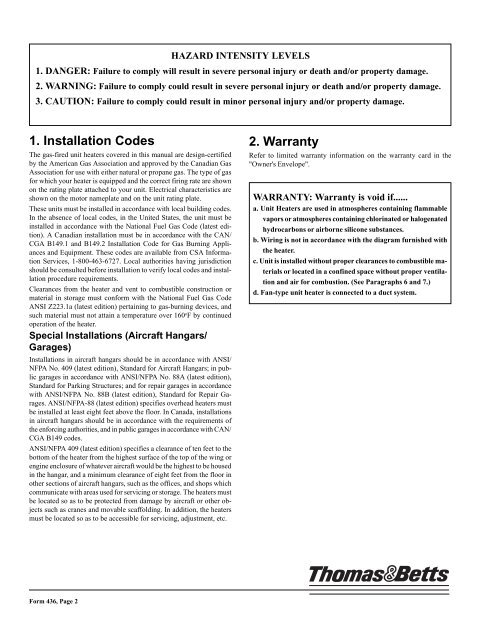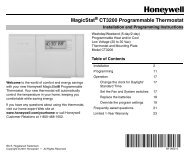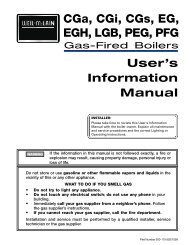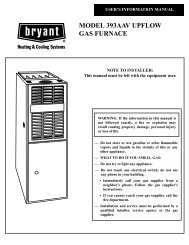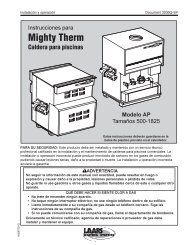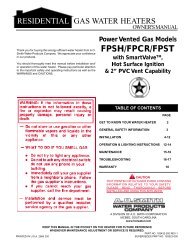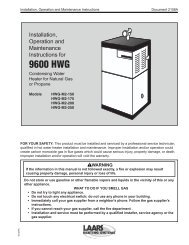GENERAL Model FE and BE - Geisel
GENERAL Model FE and BE - Geisel
GENERAL Model FE and BE - Geisel
- TAGS
- model
- geisel
- www.gogeisel.com
Create successful ePaper yourself
Turn your PDF publications into a flip-book with our unique Google optimized e-Paper software.
HAZARD INTENSITY LEVELS<br />
1. DANGER: Failure to comply will result in severe personal injury or death <strong>and</strong>/or property damage.<br />
2. WARNING: Failure to comply could result in severe personal injury or death <strong>and</strong>/or property damage.<br />
3. CAUTION: Failure to comply could result in minor personal injury <strong>and</strong>/or property damage.<br />
1. Installation Codes<br />
The gas-fired unit heaters covered in this manual are design-certified<br />
by the American Gas Association <strong>and</strong> approved by the Canadian Gas<br />
Association for use with either natural or propane gas. The type of gas<br />
for which your heater is equipped <strong>and</strong> the correct firing rate are shown<br />
on the rating plate attached to your unit. Electrical characteristics are<br />
shown on the motor nameplate <strong>and</strong> on the unit rating plate.<br />
These units must be installed in accordance with local building codes.<br />
In the absence of local codes, in the United States, the unit must be<br />
installed in accordance with the National Fuel Gas Code (latest edition).<br />
A Canadian installation must be in accordance with the CAN/<br />
CGA B149.1 <strong>and</strong> B149.2 Installation Code for Gas Burning Appliances<br />
<strong>and</strong> Equipment. These codes are available from CSA Information<br />
Services, 1-800-463-6727. Local authorities having jurisdiction<br />
should be consulted before installation to verify local codes <strong>and</strong> installation<br />
procedure requirements.<br />
Clearances from the heater <strong>and</strong> vent to combustible construction or<br />
material in storage must conform with the National Fuel Gas Code<br />
ANSI Z223.1a (latest edition) pertaining to gas-burning devices, <strong>and</strong><br />
such material must not attain a temperature over 160 o F by continued<br />
operation of the heater.<br />
Special Installations (Aircraft Hangars/<br />
Garages)<br />
Installations in aircraft hangars should be in accordance with ANSI/<br />
NFPA No. 409 (latest edition), St<strong>and</strong>ard for Aircraft Hangars; in public<br />
garages in accordance with ANSI/NFPA No. 88A (latest edition),<br />
St<strong>and</strong>ard for Parking Structures; <strong>and</strong> for repair garages in accordance<br />
with ANSI/NFPA No. 88B (latest edition), St<strong>and</strong>ard for Repair Garages.<br />
ANSI/NFPA-88 (latest edition) specifies overhead heaters must<br />
be installed at least eight feet above the floor. In Canada, installations<br />
in aircraft hangars should be in accordance with the requirements of<br />
the enforcing authorities, <strong>and</strong> in public garages in accordance with CAN/<br />
CGA B149 codes.<br />
ANSI/NFPA 409 (latest edition) specifies a clearance of ten feet to the<br />
bottom of the heater from the highest surface of the top of the wing or<br />
engine enclosure of whatever aircraft would be the highest to be housed<br />
in the hangar, <strong>and</strong> a minimum clearance of eight feet from the floor in<br />
other sections of aircraft hangars, such as the offices, <strong>and</strong> shops which<br />
communicate with areas used for servicing or storage. The heaters must<br />
be located so as to be protected from damage by aircraft or other objects<br />
such as cranes <strong>and</strong> movable scaffolding. In addition, the heaters<br />
must be located so as to be accessible for servicing, adjustment, etc.<br />
Form 436, Page 2<br />
2. Warranty<br />
Refer to limited warranty information on the warranty card in the<br />
"Owner's Envelope".<br />
WARRANTY: Warranty is void if......<br />
a. Unit Heaters are used in atmospheres containing flammable<br />
vapors or atmospheres containing chlorinated or halogenated<br />
hydrocarbons or airborne silicone substances.<br />
b. Wiring is not in accordance with the diagram furnished with<br />
the heater.<br />
c. Unit is installed without proper clearances to combustible materials<br />
or located in a confined space without proper ventilation<br />
<strong>and</strong> air for combustion. (See Paragraphs 6 <strong>and</strong> 7.)<br />
d. Fan-type unit heater is connected to a duct system.


